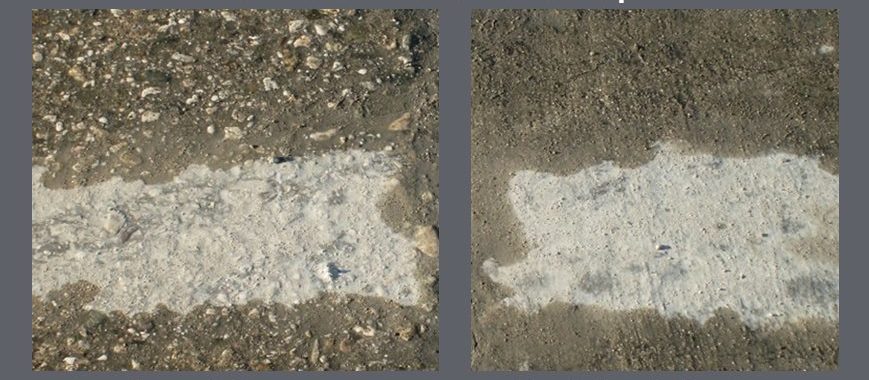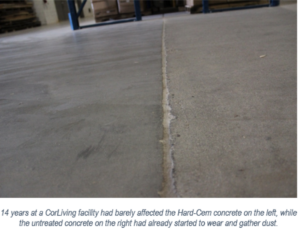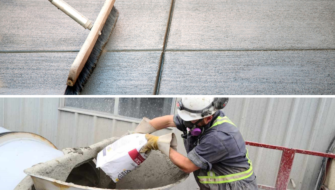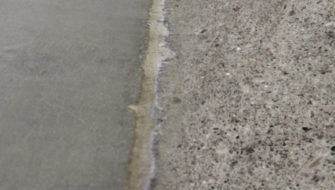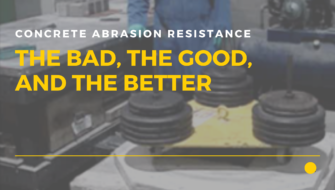Concrete is an inherently resilient and durable construction material, but it isn’t immune to the wear and tear of everyday use. Such wear and tear have implications beyond just the integrity of a building or structure — it can pose safety hazards and added costs.
Concrete erosion — the deterioration or wearing away of concrete surfaces over time by abrasive forces — can be due to a variety of reasons, and understanding these causes is critical for prevention and maintenance.
1. Constant Traffic and Heavy Machinery
In industries like logistics, distribution, intermodal yards, and port facilities, heavy loads, machinery movement, and vehicular traffic can cause the surface layer of concrete to wear down over time.
Curling and shrinkage are seriously problematic in these industries due to the sheer quantity of joints required in a large floor space. If the joints curl up, heavy machinery will hit them, creating health and safety issues and a maintenance nightmare — not just related to the floor slab but also to the machinery.
PreventionTo address this, contractors often use surface hardeners like dry shakes or liquid densifiers. However, these solutions are restrictive as they must be added in controlled precise ways, post-concrete pour, and they are incompatible with air entrainment and formed surfaces. They also degrade or delaminate over time, leaving the concrete exposed to abrasive forces and damage. Alternatively, Hard-Cem can be incorporated directly into the concrete mix by the concrete producer during batching, ensuring even distribution and offering integral hardness throughout the concrete — and creating value-added opportunities for producers serving these industries. |
2. Poor Quality Mix
If the concrete mix isn’t balanced correctly, with the right proportions of water, cement, aggregates, and additives, it might be weak or more prone to erosion.
| Prevention
Producers should always ensure a proper mix design. The use of admixtures like Hard-Cem and Kim, proper proportioning, and quality materials can improve the performance and durability of the concrete. |
3. High-Speed Water Flow
Concrete structures like dams, spillways, or coastal defenses are constantly exposed to the erosive force of water flow. To protect them, it’s essential to focus on the top layers that bear the brunt of the water action.
PreventionHard-Cem is an ideal solution to address erosion by high-speed water flow at the source, as it can be incorporated directly into the concrete mix by the concrete producer during batching, ensuring even distribution and offering integral hardness throughout the concrete. To address any cracks that do occur, KIM offers a solution that interacts directly with water and unhydrated cement particles to produce insoluble crystals that fill the concrete’s pores and micro-cracks, blocking water and contaminants from entering or exiting the structure. |
4. Improper Curing
Concrete gains strength as it hydrates over time. If it dries too quickly, it might not reach its full strength and could be more susceptible to erosion.
PreventionFinishers must properly cure the concrete by keeping it moist for an adequate amount of time, typically a week. This can be done using wet burlap, water sprays, or curing compounds. |
5. Freeze-Thaw Cycles
In any use case where concrete is exposed to water and cold weather, water can enter the concrete’s pores, freeze, expand, and cause micro-cracks. Repeated cycles exacerbate this damage, leading to scaling and crumbling as the concrete breaks apart over time.
PreventionConcrete producers can use air-entrained concrete — which has air bubbles that allow space for water to expand upon freezing — to alleviate freeze-thaw cycles. However, air entrainment can reduce strength by 5% for every 1% air added. By using KIM, you can eliminate the need to add more cement to compensate for strength reduction due to air entrainment and get the same or better freeze-thaw protection. |
While concrete is durable, it’s not invincible. However, innovations like Hard-Cem present promising solutions to the challenges of abrasion and erosion, ensuring longer life. Plus, unlike dry shakes or liquid densifiers that offer no commercial value to concrete producers, Hard-Cem is added integrally — so producers can deliver durable, value-added solutions your clients will love — and earn excellent profit margins.
After 18 years in use and application in over 7 million m^2 of concrete, Hard-Cem has proved its mettle. In the ASTM C627 (Robinson floor test), Hard-Cem demonstrated its prowess by reducing wear depth by about half compared to regular concrete and consistently outperforms dry shakes in abrasion resistance tests.
| Real-world case studies further cement (pun intended) Hard-Cem’s reputation. A facility by CorLiving used both Hard-Cem concrete and regular concrete. After 14 years, the difference in wear and tear between the two was visibly evident. |
For more information on Hard-Cem for Concrete Producers, contact our team.

